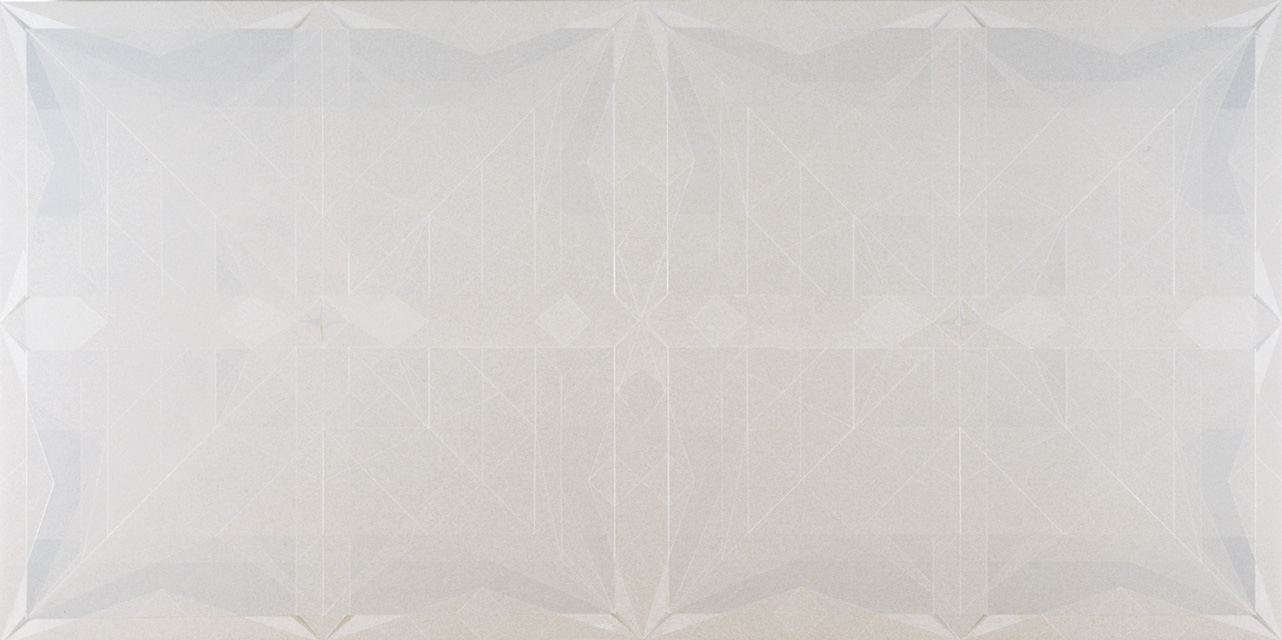


To call Robert Hunter a minimalist—as many have done—is to miss the point entirely. Indeed, while the eye may be initially deceived into recognising a white oblong, the closer reality is a baroque explosion of complex and hypnotic geometric elements. For almost twenty years, Hunter has pursued an unwavering format of large rectangles of plywood upon which he applies an extraordinary grid of masking tape. Over the tape he applies Dulux Weathershield paint in varying hues, usually, although not always, variations of white tones. As Roger Benjamin notes of Untitled no. 7 (1996):
When removed, the tapes reveal a crystalline structure of fine lines and variations in hue. Like images seen through a bleached-out kaleidoscope, each combination of lines and tones is different from the preceding one. Yet in Hunter's case the series is progressive rather than cyclical: distinctive elements can be traced across the years. All his works are powered by the eye’s ability to distinguish infinitesimal variations in hue: perceived at first glance as merely white, on close inspection extremely subtle accents of pearly yellows, pinks, greys and even blues emerge from the grid of paint.1
In 1989 Robert Hunter had a major retrospective at Monash University which had critics outbidding each other for the most enthusiastic review. This was followed by an exhibition of the paintings completed during his residency at the University of Melbourne. The year 1989 was, in effect, the year of 'the great white hunter'.
With two consecutive university-based shows, Hunter joked at the time that he had become the most 'qualified' artist in Australia. Hunter first came to light as early as 1968 with a solo show and his inclusion in The field exhibition at the National Gallery of Victoria. However, his choice to pursue what at first appear to be a stringent line of minimal paintings, even after Minimalism as a fad for many Australian artists in the early 1970s had passed, made it difficult for many to comprehend the full meaning of these works.
'I never believed that there was any emotional content in colour or any message in colour,' Hunter recalled. The results were paintings in which 'nothing had any precedence and nothing was important, visually. Just the physical existence of the paintings was all that was important'.2
This focus on the painting as such led Hunter to the art scene at arm's length. 'The only way to really approach being a painter in a place like Australia is to be not exactly isolationist, but to be working on something so specific and so personal that it has no validity to anybody else ... no gallery or art scene orientation,' he has said.3 Although Hunter had not directed his work to the art world, the art world had come to him. There had been no lack of individual exhibitions and his regular shows during the 1980s at Bruce Pollard's Pinacotheca Gallery in Richmond and the more recent shows at Anna Schwartz Gallery were well attended. The difficulties encountered by many when confronted with such strangely anti-minimalist paintings have not stopped Hunter’s growth in stature.
The works have in fact changed dramatically and steadily over the years, becoming more complex and seeing the introduction of gently haunting hints of colour. Hunter's paintings could be landscape renderings of the blazing white light experienced by near-death patients; indeed, Hunter had a near-death experience in his formative years. Whether one takes Hunter's work as sheer technical bravado or a spiritual journey, there is no disputing his importance in the Australian art world.
- Ashley Crawford
Robert Hunter is represented in Australia by Milani Gallery, Brisbane.